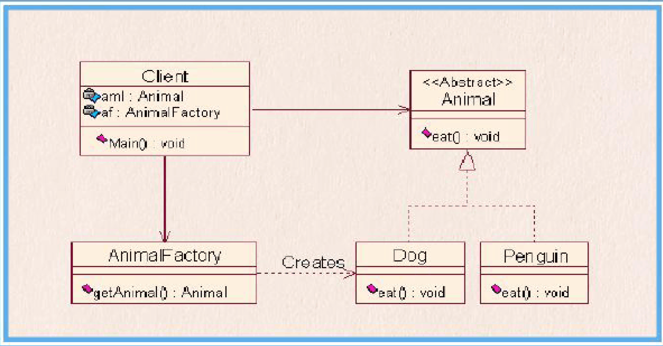设计模式分类:
创建型模式。
结构型模式。
行为模式。
23种设计模式,如何记。面向对象的系统中有很多对象,创建型模式解决的问题就是如何创建对象,何时创建对象,它努力的让代码不要太多的关注对象的具体类型,不用关注对象的创建细节,而知需要了解对象的抽象类型,创建对象的工作由创建对象的工厂来实现。
面向对象的系统中,对象如何组织,采用什么样的结构组织比较合理,这个是由结构型模式来处理的。合理的使用结构型模式可以使系统具备更好的灵活性、扩展性和维护性。
行为模式规定了各个对象间的应该具备的职责。
严格来说,简单工厂模式并不是23种标准模式之一,它是工厂家族中最简单的模式,使用这个模式可以把对象的创建和对象的使用分离开,工厂只负责对象的创建,客户端程序调用和使用对象,客户端程序无需创建对象。这样对象的创建放在一起,方便维护和扩展。现实中生产鞋子的工厂负责生产鞋子,我们不需要知道生产的鞋子的具体类型。

如图所示:右上角是一个产品接口,我们可以使用接口或抽象类来定义一个产品对象。Animal类中有一个行为吃,Animal类派生出两个子类:Dog、Penguin。这两个类分别实现了吃的动作,这两个动物其实是简单工厂中具体的产品,通过他们实现抽象的产品;这些动物该如何去创建呢,我们可以用动物工厂AnimalFactory来创建具体的动物,AnimalFactory类中有一个GetAnimal的方法,在这个方法里我们可以根据传进去的参数来创建具体的产品,工厂类和产品类是依赖的关系。
在客户端,它关联了抽象的产品类Animal和工厂类AnimalFactory,对客户来说,他不需要了解具体的产品,只需要告诉工厂,需要什么具体的动物,动物工厂就会根据客户端的要求来创建某个动物,通过简单工厂模式,使客户端程序与具体的产品之间减少耦合度。
示例:
抽象动物类:
1 using System; 2 using System.Collections.Generic; 3 using System.Linq; 4 using System.Text; 5 using System.Threading.Tasks; 6 7 namespace 简单工厂模式 8 { 9 /* 10 动物抽象类 11 * 抽象产品 12 */ 13 public abstract class Animal 14 { 15 public abstract void Eat(); 16 } 17 }
具体动物狗类:
1 using System; 2 using System.Collections.Generic; 3 using System.Linq; 4 using System.Text; 5 using System.Threading.Tasks; 6 7 namespace 简单工厂模式 8 { 9 /* 10 具体的产品类,实现抽象产品类 11 */ 12 public class Dog:Animal 13 { 14 // 实现抽象方法 15 public override void Eat() 16 { 17 Console.WriteLine("狗在吃饭!"); 18 } 19 } 20 }
具体动物企鹅类:
1 using System; 2 using System.Collections.Generic; 3 using System.Linq; 4 using System.Text; 5 using System.Threading.Tasks; 6 7 namespace 简单工厂模式 8 { 9 /* 10 具体产品类,实现抽象产品类 11 12 */ 13 public class Penguin :Animal 14 { 15 // 实现抽象方法 16 public override void Eat() 17 { 18 Console.WriteLine("企鹅在吃饭!"); 19 } 20 } 21 }
动物工厂类:
1 using System; 2 using System.Collections.Generic; 3 using System.Linq; 4 using System.Text; 5 using System.Threading.Tasks; 6 7 namespace 简单工厂模式 8 { 9 /* 10 动物工厂类:实现具体的动物 11 12 */ 13 public class AnimalFactory 14 { 15 /// <summary> 16 /// 根据客户的选择创建动物对象 17 /// </summary> 18 /// <param name="witch">动物编号</param> 19 /// <returns></returns> 20 public Animal GetAnimal(int witch) 21 { 22 Animal am = null; 23 switch (witch) 24 { 25 case 1: 26 am = new Dog(); 27 break; 28 case 2: 29 am = new Penguin(); 30 break; 31 } 32 33 return am; 34 } 35 } 36 }
主程序调用测试
1 using System; 2 using System.Collections.Generic; 3 using System.Linq; 4 using System.Text; 5 using System.Threading.Tasks; 6 7 namespace 简单工厂模式 8 { 9 class Program 10 { 11 static void Main(string[] args) 12 { 13 // 得到具体的动物 (里氏替换原则) 14 Animal am = new AnimalFactory().GetAnimal(1); 15 // 调用Eat()方法 16 am.Eat(); // 输出狗在吃饭 17 18 Console.ReadKey(); 19 } 20 } 21 }
测试结果:

使用接口实现简单工厂模式
需求:使用面向对象的方式设计一个系统,描述使用卡车从事货运,使用公共汽车从事客运。使用工厂模式实现。
1、汽车接口:
1 using System; 2 using System.Collections.Generic; 3 using System.Linq; 4 using System.Text; 5 using System.Threading.Tasks; 6 7 namespace 简单工厂模式 8 { 9 /// <summary> 10 /// 汽车接口 11 /// </summary> 12 public interface ICar 13 { 14 /// <summary> 15 /// 描述汽车从事的活动 16 /// </summary> 17 void Work(); 18 } 19 }
2、分别定义卡车类(Truck)和公共汽车类(Bus)实现ICar接口
Truck类:
1 using System; 2 using System.Collections.Generic; 3 using System.Linq; 4 using System.Text; 5 using System.Threading.Tasks; 6 7 namespace 简单工厂模式 8 { 9 /// <summary> 10 /// 卡车类 11 /// </summary> 12 public class Truck : ICar 13 { 14 /// <summary> 15 /// 卡车从事的活动 16 /// </summary> 17 public void Work() 18 { 19 Console.WriteLine("卡车从事货运"); 20 } 21 } 22 }
Bus类:
1 using System; 2 using System.Collections.Generic; 3 using System.Linq; 4 using System.Text; 5 using System.Threading.Tasks; 6 7 namespace 简单工厂模式 8 { 9 /// <summary> 10 /// 公共汽车类 11 /// </summary> 12 public class Bus:ICar 13 { 14 /// <summary> 15 /// 公共汽车从事的活动 16 /// </summary> 17 public void Work() 18 { 19 Console.WriteLine("公共汽车从事客运"); 20 } 21 } 22 }
3、定义汽车的工厂类
1 using System; 2 using System.Collections.Generic; 3 using System.Linq; 4 using System.Text; 5 using System.Threading.Tasks; 6 7 namespace 简单工厂模式 8 { 9 /// <summary> 10 /// 汽车工厂类:返回具体的汽车类 11 /// </summary> 12 public class CarFactory 13 { 14 /// <summary> 15 /// 根据汽车编号创建具体的汽车对象 16 /// </summary> 17 /// <param name="witch">汽车编号</param> 18 /// <returns></returns> 19 public ICar GetCar(int witch) 20 { 21 ICar car = null; 22 switch (witch) 23 { 24 case 1: 25 car= new Truck(); 26 break; 27 case 2: 28 car = new Bus(); 29 break; 30 } 31 return car; 32 } 33 } 34 }
4、主程序调用
1 using System; 2 using System.Collections.Generic; 3 using System.Linq; 4 using System.Text; 5 using System.Threading.Tasks; 6 7 namespace 简单工厂模式 8 { 9 class Program 10 { 11 static void Main(string[] args) 12 { 13 // 得到具体的汽车 14 ICar car = new CarFactory().GetCar(2); 15 // 调用Work()方法 16 car.Work(); 17 Console.ReadKey(); 18 } 19 } 20 }
5、程序运行结果

简单工厂模式的缺点:
增加具体产品时,需要修改工厂类里面生成具体产品的方法,这就违反了开闭原则。具体产品经常发生变化时,不建议使用简单工厂模式。
代码连接地址:http://files.cnblogs.com/files/dotnet261010/%E8%AE%BE%E8%AE%A1%E6%A8%A1%E5%BC%8F.rar